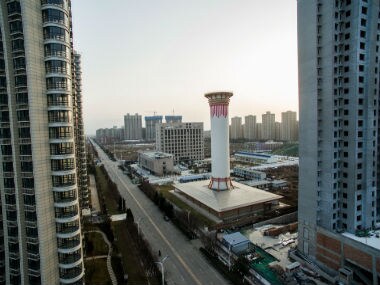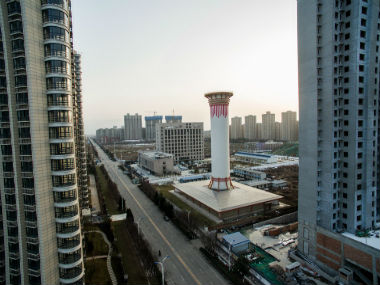From Dutch technology that can turn smog into diamonds to breakthroughs like modified bacteria that feed on carbon dioxide from Israel, researchers all over the world are looking for ways to ensure that citizens have clean fresh air to breathe. To be sure, scientists have argued that there is no substitute for reducing emissions. But these inventions have been shown to repurpose elements in air pollution like nitrous oxide, carbon particles and tiny particulate matter which have been linked to health conditions from allergies to brain stroke. [caption id=“attachment_7728911” align=“alignleft” width=“380”]
 Air purifier tower in Xi’an, China. Image source: Getty Images.[/caption] On National Pollution Prevention Day 2019, we look at seven such inventions to curb air pollution: 1. Carbon ink: If you are a fan of Indian street art, then you’ve undoubtedly heard of Daku. For the 2016 St + Art Delhi street art festival, the artist wrote just one word on a stark white wall: “Breathe”. Students at the Indian Institute of Technology Delhi had made the black ink for the artwork with 2.5 mm particulate matter. Today, Gurgaon-based startup Chakr Innovation can turn the same trick, turning the exhaust from your car engine into ink before it can escape and make the air you breathe dirtier. Halfway around the world in Mexico, Spanish collective Boa Mistura recently painted a 35-metre on Paseo de la Reforma boulevard. The mural, which depicts a tree, is painted with a special material called Airlite which contains chemicals that release oxygen when sunlight falls on them. Also read:
Scientists create bacteria that eat carbon dioxide, clean up the environment
2. Smog diamonds: You probably remember this from class 8 science: diamonds are just super-compressed carbon. And since the traditional method of mining diamonds poses many environmental problems itself, using the carbon all around us to produce them could kill two birds with one stone. Dutch artist Daan Roosegaarde developed a technology to harness carbon from smog and pressurise it for just 30 minutes to make sparkling diamonds. The artist has launched his “Smog Free Project” in China, South Korea, the Netherlands and Poland. 3. Air pollution tower: Last year, China’s Institute of Earth Environment built a 100-meter tower to filter the air in Xian city. Scientists who developed the tower have since reported that it can filter up to 10 million cubic meters of air per day. The jury is still out, though, on whether this small pocket of cleanish air is the best way forward. Some researchers say that since the tower does nothing about the pollution in the upper layers of the environment, it leaves a lot to be desired. Also read:
Scientists figure out a way to remove carbon dioxide and clear the air
4. BioSolar Leaf: Earlier this year, London’s Imperial College collaborated with a startup called Arborea to plant microalgae, diatoms and phytoplankton, on large panels over part of the campus. The “microplants” on the panels are expected to clean the air; the same way that their larger cousins (regular plants) do. 5. NOx paint: A patented technology, this paint is made of a silicon-based polymer embedded with “spherical nanoparticles of titanium dioxide and calcium carbonate 30 nanometres wide”. The paint, which has been commercially available in Europe for the last 15 years, is supposed to soak up nitrogen oxide - a noxious emission from factory and car exhausts - that has been linked with ailments like chronic lung disease. As new research uncovers more health effects of air pollution (there is new research that claims exposure to air pollution can increase your risk of blindness), continued research into ways to combat this evil show us that where there is science, there’s still hope. Health articles in Firstpost are written by myUpchar.com, India’s first and biggest resource for verified medical information. At myUpchar, researchers and journalists work with doctors to bring you information on all things health. For more information, please read our article on
Lung Disease: Causes, Symptoms, Treatment, Prevention
_._
Air purifier tower in Xi’an, China. Image source: Getty Images.[/caption] On National Pollution Prevention Day 2019, we look at seven such inventions to curb air pollution: 1. Carbon ink: If you are a fan of Indian street art, then you’ve undoubtedly heard of Daku. For the 2016 St + Art Delhi street art festival, the artist wrote just one word on a stark white wall: “Breathe”. Students at the Indian Institute of Technology Delhi had made the black ink for the artwork with 2.5 mm particulate matter. Today, Gurgaon-based startup Chakr Innovation can turn the same trick, turning the exhaust from your car engine into ink before it can escape and make the air you breathe dirtier. Halfway around the world in Mexico, Spanish collective Boa Mistura recently painted a 35-metre on Paseo de la Reforma boulevard. The mural, which depicts a tree, is painted with a special material called Airlite which contains chemicals that release oxygen when sunlight falls on them. Also read:
Scientists create bacteria that eat carbon dioxide, clean up the environment
2. Smog diamonds: You probably remember this from class 8 science: diamonds are just super-compressed carbon. And since the traditional method of mining diamonds poses many environmental problems itself, using the carbon all around us to produce them could kill two birds with one stone. Dutch artist Daan Roosegaarde developed a technology to harness carbon from smog and pressurise it for just 30 minutes to make sparkling diamonds. The artist has launched his “Smog Free Project” in China, South Korea, the Netherlands and Poland. 3. Air pollution tower: Last year, China’s Institute of Earth Environment built a 100-meter tower to filter the air in Xian city. Scientists who developed the tower have since reported that it can filter up to 10 million cubic meters of air per day. The jury is still out, though, on whether this small pocket of cleanish air is the best way forward. Some researchers say that since the tower does nothing about the pollution in the upper layers of the environment, it leaves a lot to be desired. Also read:
Scientists figure out a way to remove carbon dioxide and clear the air
4. BioSolar Leaf: Earlier this year, London’s Imperial College collaborated with a startup called Arborea to plant microalgae, diatoms and phytoplankton, on large panels over part of the campus. The “microplants” on the panels are expected to clean the air; the same way that their larger cousins (regular plants) do. 5. NOx paint: A patented technology, this paint is made of a silicon-based polymer embedded with “spherical nanoparticles of titanium dioxide and calcium carbonate 30 nanometres wide”. The paint, which has been commercially available in Europe for the last 15 years, is supposed to soak up nitrogen oxide - a noxious emission from factory and car exhausts - that has been linked with ailments like chronic lung disease. As new research uncovers more health effects of air pollution (there is new research that claims exposure to air pollution can increase your risk of blindness), continued research into ways to combat this evil show us that where there is science, there’s still hope. Health articles in Firstpost are written by myUpchar.com, India’s first and biggest resource for verified medical information. At myUpchar, researchers and journalists work with doctors to bring you information on all things health. For more information, please read our article on
Lung Disease: Causes, Symptoms, Treatment, Prevention
_._
National Pollution Prevention Day 2019: Where there is science, there is hope
Myupchar
• December 2, 2019, 18:09:47 IST
As new research uncovers more health effects of air pollution, continued research into ways to combat this evil shows us that there’s hope.
Advertisement
)
End of Article